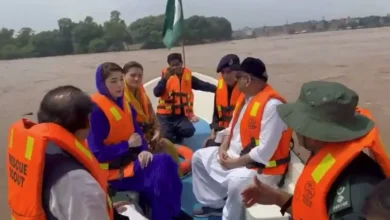LAHORE: Senior Provincial Minister Marriyum Aurangzeb revealed on Saturday that devastating floods triggered by three major rivers have affected over 1.5 million people across 2,038 villages in Punjab, leaving 30 dead and thousands displaced.
The floods, driven by rising waters in the Chenab, Ravi, and Sutlej rivers, have been declared among the most destructive in the province’s history.
Minister Aurangzeb confirmed that Chief Minister Maryam Nawaz Sharif is directly overseeing a large-scale rescue and relief operation. “In this critical time, the chief minister stands firmly with the people,” she said.
Relentless Relief Efforts Underway
According to the minister, more than 481,000 individuals have been relocated to safer locations, and 511 relief camps along with 351 medical camps are operating round the clock to provide essential care. Additionally, 6,373 flood victims are currently sheltered in relief camps.

Emergency response has included the deployment of 808 boats, which have rescued 68,477 people in just 36 hours.
Also Read: Pakistan braces for more floods as PDMA warns of heavy inflows from India
The coordinated effort involves ministers, lawmakers, district administration, Rescue 1122, police, civil defense, and other key institutions working as “a united force,” she added.
Protection of Livestock and Veterinary Support
In addition to human rescue efforts, over 405,000 livestock have been safely relocated, with 321 veterinary camps established to provide medical assistance to animals affected by the floods.
Aurangzeb credited the proactive measures taken by Chief Minister Maryam Nawaz – including early warnings and anti-encroachment operations – for helping reduce the scale of human loss.

“Despite being one of the worst floods in our history, Punjab has been spared a larger tragedy due to timely actions,” she stated.
Planning for Future Resilience
The minister also emphasized the need for long-term climate resilience strategies, vowing to implement advanced early-warning systems across the province. “Climate change has turned into a full-scale disaster. We will formulate a comprehensive strategy based on lessons learned during this flood,” she said.
Looking ahead, Aurangzeb confirmed that a post-flood anti-encroachment drive will be launched as part of recovery efforts.
“Our top priority is the rehabilitation of affected citizens and compensation for losses,” she said.
Meanwhile, the flood threat has eased in Punjab’s capital, Lahore, but a historic water flow at Ganda Singh Wala in Sutlej River has triggered severe flood threat with raging water advancing toward south.
Water discharge at Ganda Singh Wala on the Sutlej River has decreased from 390,000 cusecs to approximately 303,828 cusecs as of 6 am, but flood risks remain high at Head Suleimanki and Head Islam.
So far, 28 fatalities have been reported in flood-related incidents across the province.
Kasur Faces Historic Flood Surge
According to the Flood Forecasting Division, the flood level at Ganda Singh Wala on the Sutlej River remains extremely high, prompting authorities to evacuate villages near Talwar Post.
The unprecedented flow is the highest recorded since 1955, with rising water levels attributed to a breach of a dam in India. Officials warn that protecting Kasur city remains a significant challenge.
.jpg)
Multan Braces for Major Flood Influx
A massive flood surge is expected to enter Multan by this evening, with over 300,000 people already displaced due to flooding in surrounding areas.
Locals have complained about inadequate rescue boats and the lack of arrangements for moving livestock, further complicating evacuation efforts.
Chistian
The outskirts of Chishtian have also witnessed floods caused by the overflowing Sutlej River, resulting in water entering homes and villages. Approximately 50 settlements are severely impacted, and residents are being moved to safer locations.
Also Read: Field Marshal Asim Munir visits flood-hit Punjab, promises to restore Kartarpur Gurdwara
Ravi River Levels Surge, Lahore Remains Safe
Water levels at Head Balloki on the Ravi River continue to rise, reaching 192,545 cusecs, with Head Sidhnai also seeing increases. However, flow has reduced at Shahdara Lahore and Jassar, providing some relief to Lahore city. Meanwhile, floodwaters continue to rise at Head Panjnad on the Chenab River.
Floods Devastate Sialkot and Surrounding Areas
A breach near Budiana town in Sialkot has submerged several villages, isolating dozens of communities due to damage on the only route connecting Zafarwal and Lahri. Thousands of acres of rice crops have been destroyed, and traffic on the Sialkot-Pasrur road has been halted. Over 85 villages in Bajwat have lost land connectivity with Sialkot, leaving residents trapped.
Flood Impact Expands in Rajanpur, Bahawalpur, and Faisalabad
At Jalalpur Pirwala, the Sutlej River is flowing at 50,000 cusecs, impacting 140 villages. Rajanpur officials are relocating residents from low-lying areas due to the high flood threat. In Bahawalpur, migration from flood-prone areas continues, while Faisalabad’s Tandlianwala tehsil remains on high alert with ongoing evacuations.
Chenab Floods Affect Hafizabad, Gujranwala
Floodwaters from the Chenab have severely affected districts like Hafizabad and Gujranwala, submerging 40 villages in Hafizabad alone.
Sindh and Balochistan Prepare for Incoming Flood Threat
The National Disaster Management Authority (NDMA) has warned of severe flooding risks in Sindh, with the Indus River expected to witness surges of up to 900,000 cusecs in early September.
Floodwaters released from upstream barrages in India and Punjab could inundate lower Sindh areas.
Balochistan also faces flood threats, with water expected to enter the province from the Indus River by September 2. Districts including Jaffarabad, Rojhan, Usta Muhammad, and Sohbatpur are at risk of flooding. Provincial authorities have set up a camp office in Naseerabad to monitor the situation closely.
Punjab flood aid efforts intensify
The National Disaster Management Authority (NDMA) on Saturday provided 500 ration bags each to flood-hit Sialkot and Narowal, containing 46 kilograms of essential supplies comprising 22 items to be distributed through respective district administrations to support affected residents.
According to an NDMA spokesman, a contingent of eight trucks carrying relief supplies was dispatched to Sialkot and Narowal districts following a request from the Provincial Disaster Management Authority (PDMA) Punjab to deliver rations to flood victims as part of ongoing relief and rescue operations in flood-affected areas under directives from the Prime Minister of Pakistan.
According to the National Disaster Management Authority (NDMA) spokesperson, the authority will dispatch a total of 4,200 relief ration bags to flood-affected areas in Punjab, each package designed to meet the immediate needs of affected families by providing essential food items and other necessities.
The NDMA will dispatch relief trucks in the coming days to flood-hit Wazirabad, Hafizabad, Jhang, and Chiniot with 500 ration packs each for Wazirabad and Hafizabad, 1,000 for Chiniot, and 1,200 for Jhang, while coordinating with provincial authorities to ensure timely delivery of essential supplies.







